Abstract
Of the babies admitted to the Special Care Baby Unit of the Royal Free Hospital over 20 months, 10·2% were infected or colonised by klebsiella. The fluorescent antibody technique was used to identify epidemics caused by three strains: capsular type 8 K. aerogenes, type 68 K. oxytoca, or type 13 K. aerogenes, each of which was predominant at a different time, exhibited a difference in virulence, and showed a predilection for different sites of infection. Intestinal colonisation was frequently followed by the presence of sepsis in other sites by the same capsular type. Antibiotic administration led to a higher incidence of klebsiella infection, while the widespread use of compounds containing hexachlorophane could have contributed to skin colonisation and infection by klebsiella. An environmental survey indicated that 1% Hycolin failed to disinfect the incubators, that the babies were the reservoirs of the organisms, and that transmission was due to inadequate hand-washing of nurses and mothers. The mothers were found to have been uninformed of hygienic techniques. They were observed in various practices which could have contributed to the spread of the organism, including contaminating communal areas and handling babies other than their own. It has been recommended that the mothers of premature infants be instructed in the hygienic measures required in dealing with this susceptible population and that the nursing and medical staff be more strict in their own observance of these procedures.
Full text
PDF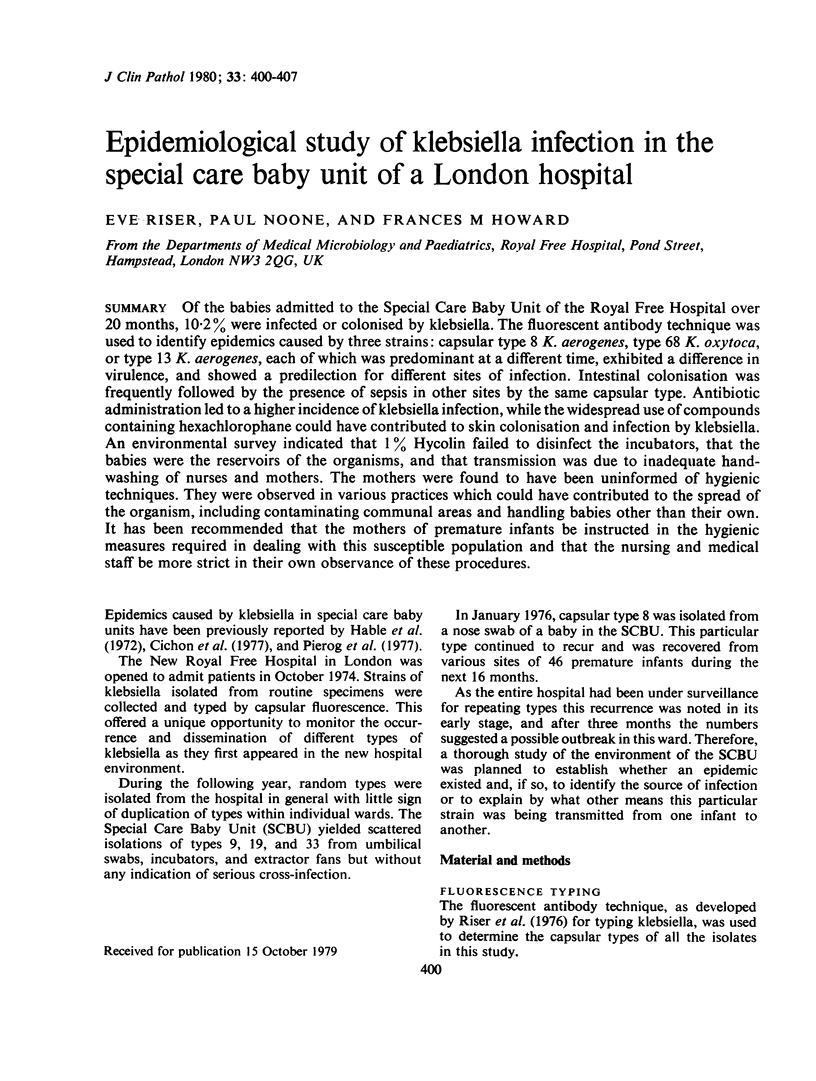
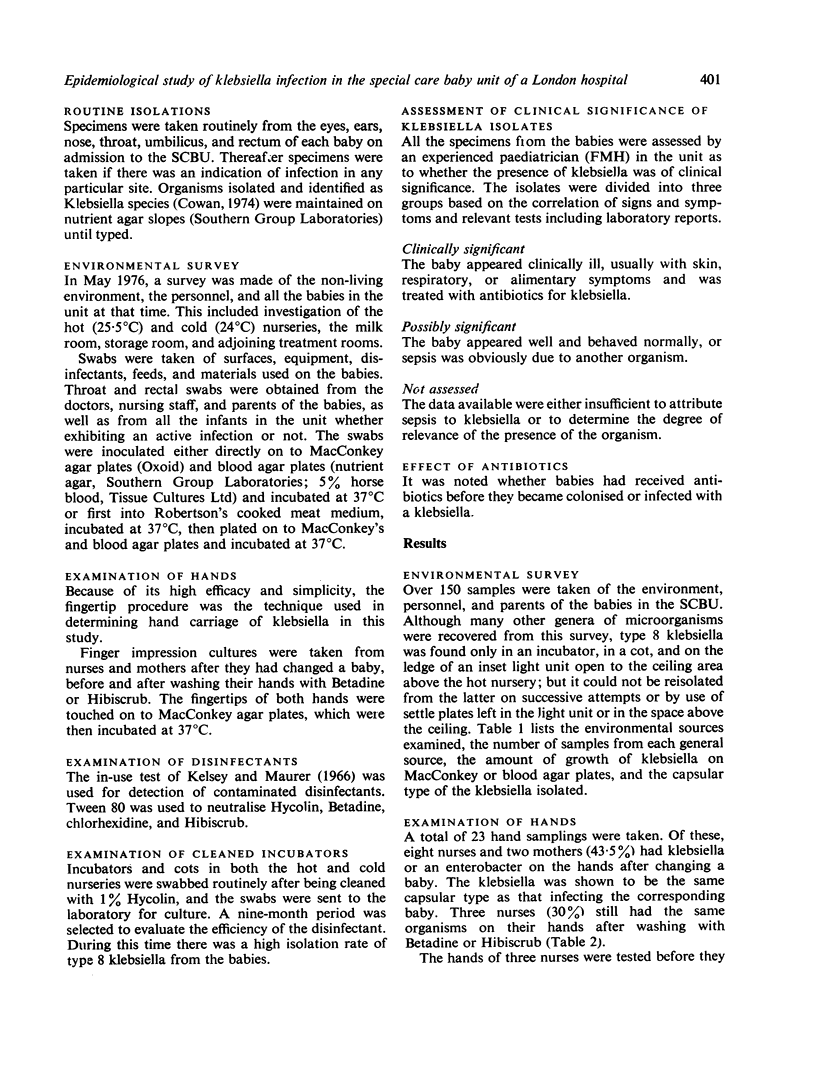
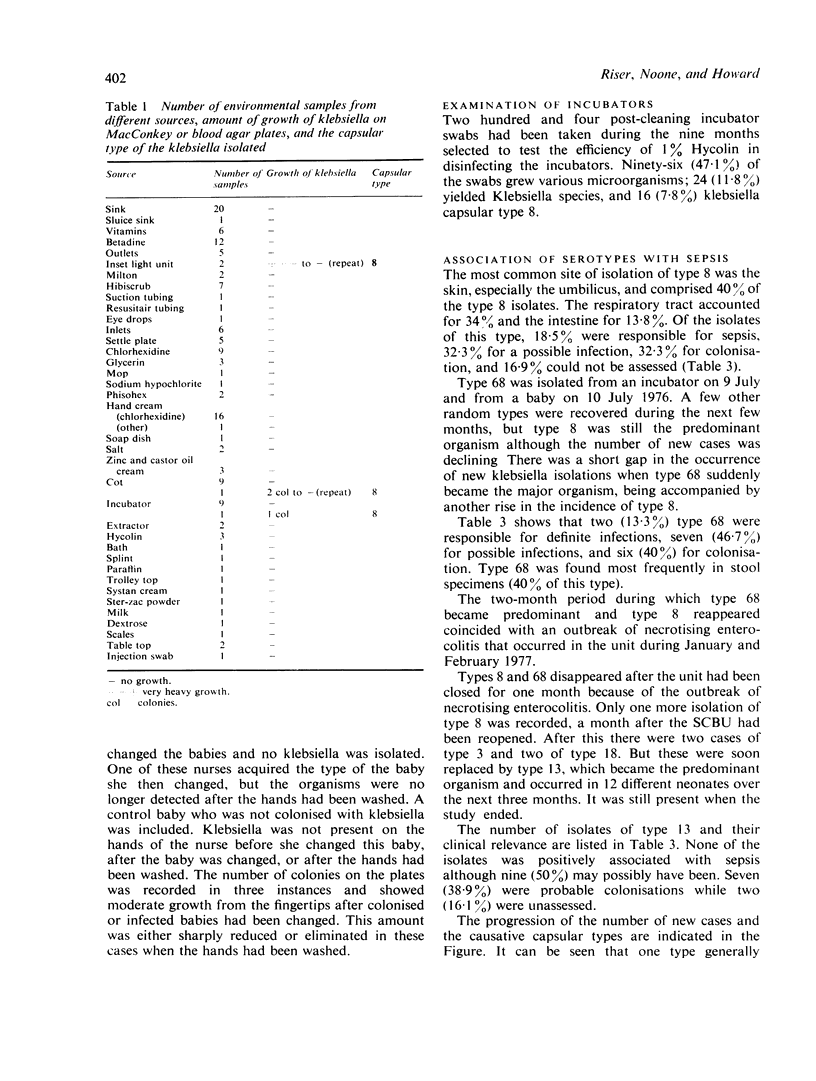
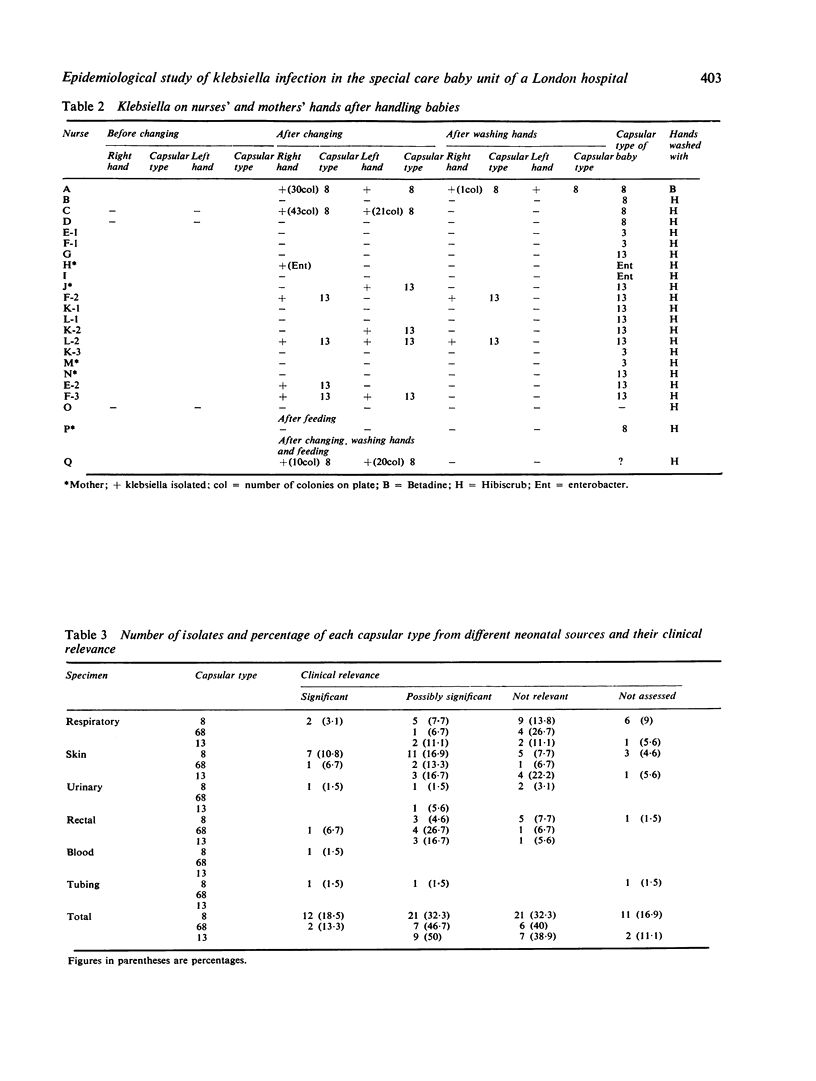
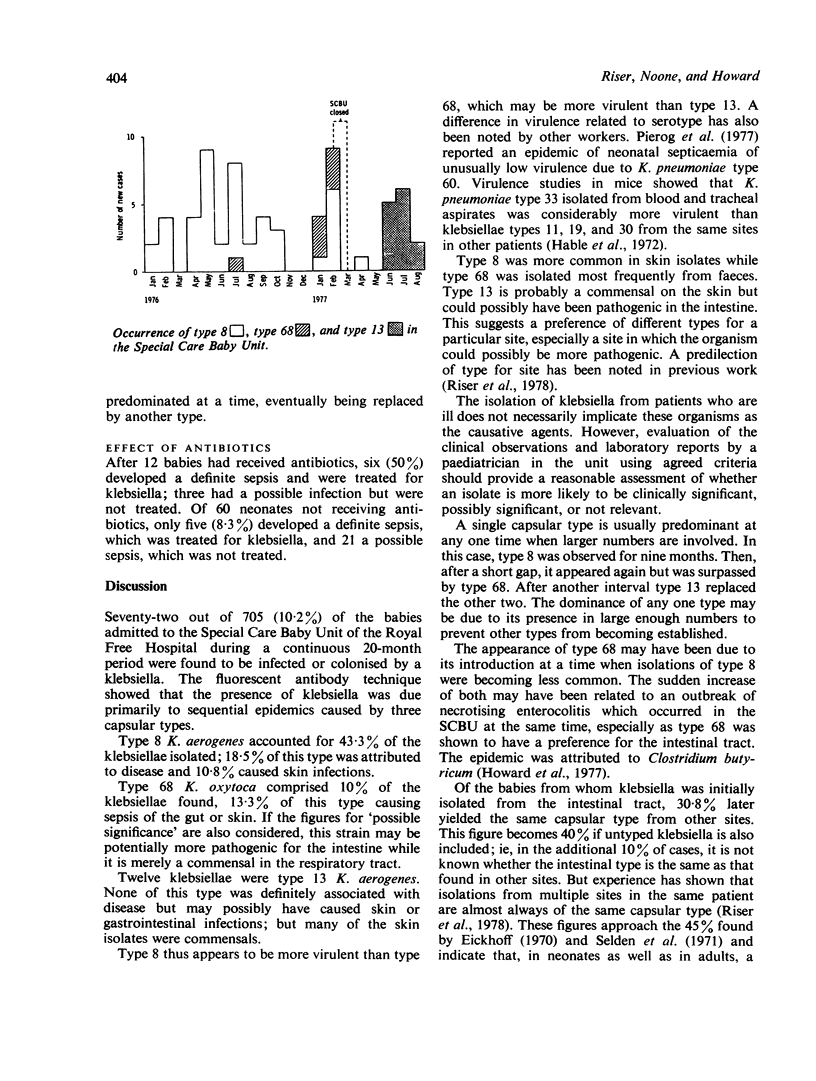
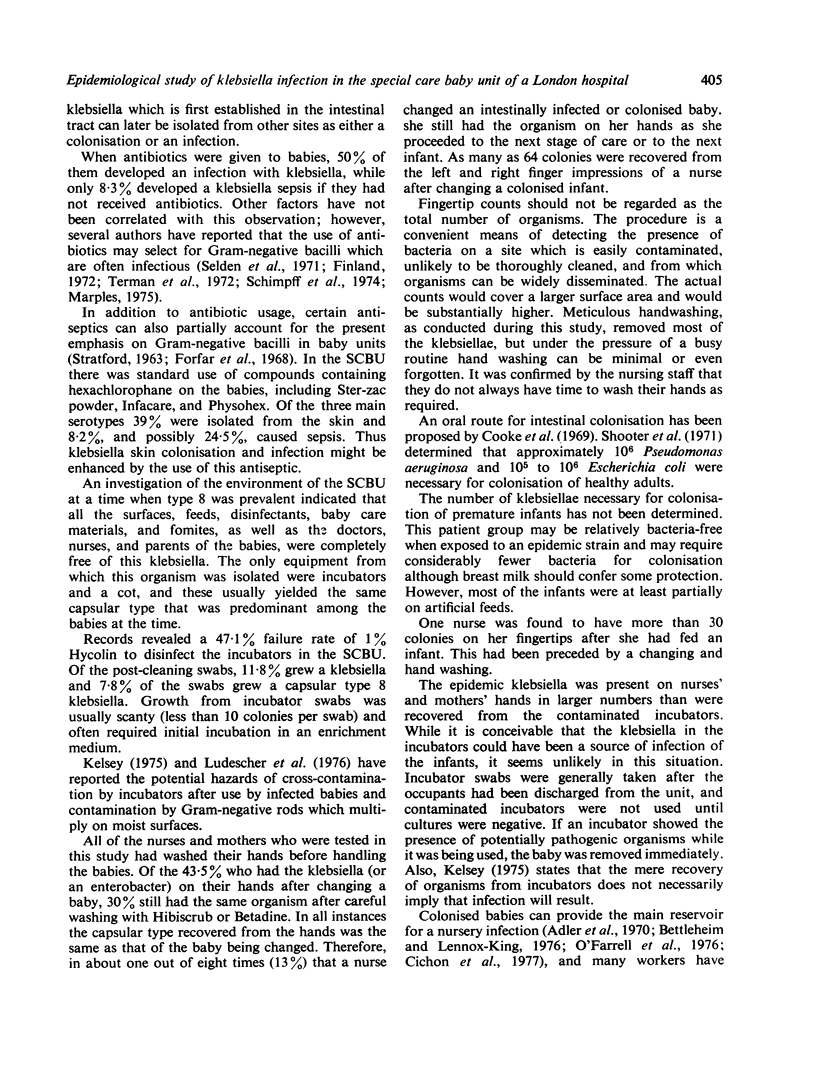
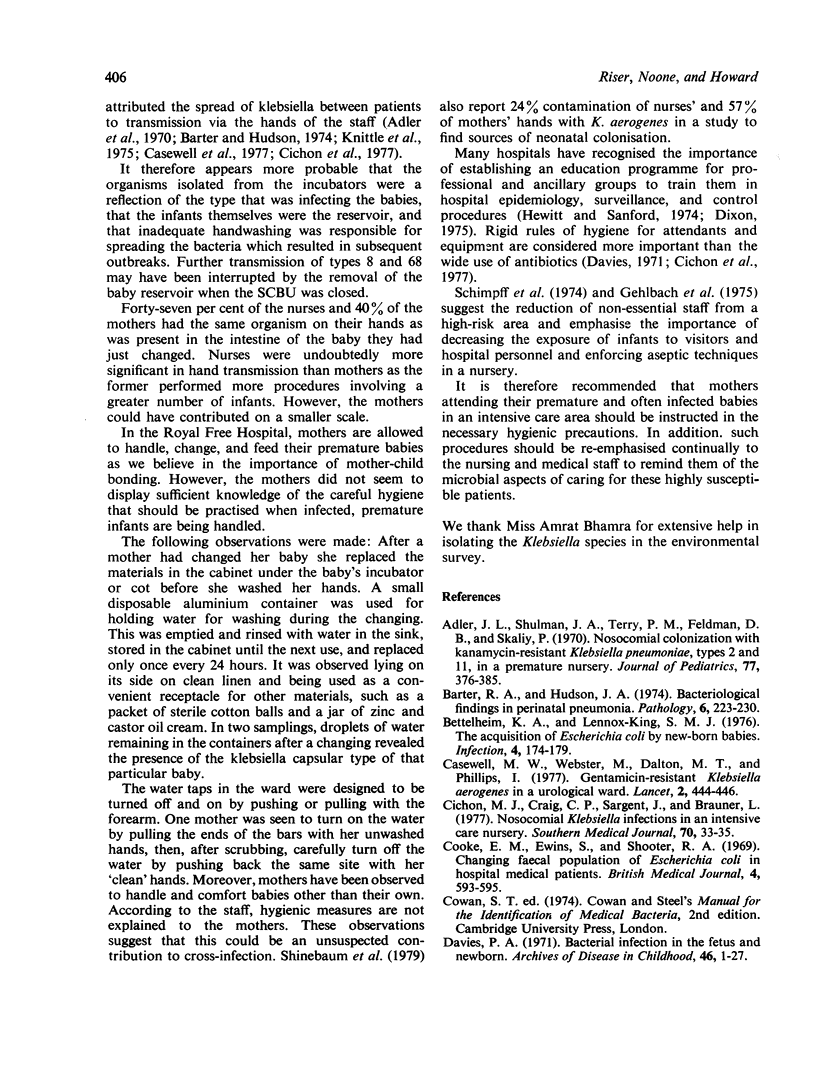

Selected References
These references are in PubMed. This may not be the complete list of references from this article.
- Adler J. L., Shulman J. A., Terry P. M., Feldman D. B., Skaliy P. Nosocomial colonization with kanamycin-resistant Klebsiella pneumoniae, types 2 and 11, in a premature nursery. J Pediatr. 1970 Sep;77(3):376–385. doi: 10.1016/s0022-3476(70)80004-x. [DOI] [PubMed] [Google Scholar]
- Barter R. A., Hudson J. A. Bacteriological findings in perinatal pneumonia. Pathology. 1974 Jul;6(3):223–230. doi: 10.3109/00313027409068989. [DOI] [PubMed] [Google Scholar]
- Bettelheim K. A., Lennox-King S. M. The acquisition of Escherichia coli by new-born babies. Infection. 1976;4(3):174–179. doi: 10.1007/BF01638945. [DOI] [PubMed] [Google Scholar]
- Casewell M. W., Dalton M. T., Webster M., Phillips I. Gentamicin-resistant Klebsiella aerogenes in a urological ward. Lancet. 1977 Aug 27;2(8035):444–446. doi: 10.1016/s0140-6736(77)90621-3. [DOI] [PubMed] [Google Scholar]
- Cichon M. J., Craig C. P., Sargent J., Brauner L. Nosocomial Klebsiella infections in an intensive care nursery. South Med J. 1977 Jan;70(1):33–35. doi: 10.1097/00007611-197701000-00016. [DOI] [PubMed] [Google Scholar]
- Cooke E. M., Ewins S., Shooter R. A. Changing faecal population of Escherichia coli in hospital medical patients. Br Med J. 1969 Dec 6;4(5683):593–595. doi: 10.1136/bmj.4.5683.593. [DOI] [PMC free article] [PubMed] [Google Scholar]
- Davies P. A. Bacterial infection in the fetus and newborn. Arch Dis Child. 1971 Feb;46(245):1–27. doi: 10.1136/adc.46.245.1. [DOI] [PMC free article] [PubMed] [Google Scholar]
- Eickhoff T. C. Microbiological sampling. Hospitals. 1970 Apr 16;44(8):86–87. [PubMed] [Google Scholar]
- Finland M. Changing patterns of susceptibility of common bacterial pathogens to antimicrobial agents. Ann Intern Med. 1972 Jun;76(6):1009–1036. doi: 10.7326/0003-4819-76-6-1009. [DOI] [PubMed] [Google Scholar]
- Forfar J. O., Gould J. C., Maccabe A. F. Effect of hexachlorophane on incidence of staphylococcal and gram-negative infection in the newborn. Lancet. 1968 Jul 27;2(7561):177–179. doi: 10.1016/s0140-6736(68)92618-4. [DOI] [PubMed] [Google Scholar]
- Gehlbach S. H., Gutman L. T., Wilfert C. M., Brumley G. W., Katz S. L. Recurrence of skin disease in a nursery: ineffectuality of hexachlorophene bathing. Pediatrics. 1975 Mar;55(3):422–424. [PubMed] [Google Scholar]
- Hable K. A., Matsen J. M., Wheeler D. J., Hunt C. E., Quie P. G. Klebsiella type 33 septicemia in an infant intensive care unit. J Pediatr. 1972 Jun;80(6):920–924. doi: 10.1016/s0022-3476(72)80002-7. [DOI] [PubMed] [Google Scholar]
- Hewitt W. L., Sanford J. P. Workshop on hospital-associated infections. J Infect Dis. 1974 Dec;130(6):680–686. doi: 10.1093/infdis/130.6.680. [DOI] [PubMed] [Google Scholar]
- Howard F. M., Flynn D. M., Bradley J. M., Noone P., Szawatkowski M. Outbreak of necrotising enterocolitis caused by Clostridium butyricum. Lancet. 1977 Nov 26;2(8048):1099–1102. doi: 10.1016/s0140-6736(77)90546-3. [DOI] [PubMed] [Google Scholar]
- Kelsey J. C. Letter: Hygiene of babies' incubators. Lancet. 1975 Feb 22;1(7904):455–456. doi: 10.1016/s0140-6736(75)91526-3. [DOI] [PubMed] [Google Scholar]
- Knittle M. A., Eitzman D. V., Baer H. Role of hand contamination of personnel in the epidemiology of gram-negative nosocomial infections. J Pediatr. 1975 Mar;86(3):433–437. doi: 10.1016/s0022-3476(75)80980-2. [DOI] [PubMed] [Google Scholar]
- Ludescher E., Breitfellner G., Troy E. Klinisch und epidemiologisch ungewöhnliche Infektion mit E. coli 0 111: B4 auf einer Neugeborenenabteilung. Padiatr Padol. 1976;11(2-2):428–434. [PubMed] [Google Scholar]
- O'Farrell S. M., Lennox-King S. M., Bettelheim K. A., Shaw E. J., Shooter R. A. Escherichia coli in a maternity ward. Infection. 1976;4(3):146–152. doi: 10.1007/BF01638941. [DOI] [PubMed] [Google Scholar]
- Pierog S., Nigam S., Lala R. V., Crichlow D. K., Evans H. E. Neonatal septicemia due to Klebsiella pneumoniae type 60. Epidemic of unusually low virulence. N Y State J Med. 1977 Apr;77(5):737–741. [PubMed] [Google Scholar]
- Riser E., Noone P., Poulton T. A. A new serotyping method for Klebsiella species: development of the technique. J Clin Pathol. 1976 Apr;29(4):296–304. doi: 10.1136/jcp.29.4.296. [DOI] [PMC free article] [PubMed] [Google Scholar]
- Riser E., Noone P., Thompson R. E. The use of a fluorescence typing method in an epidemiological study of Klebsiella infection in a London hospital. J Hyg (Lond) 1978 Feb;80(1):43–56. doi: 10.1017/s0022172400053389. [DOI] [PMC free article] [PubMed] [Google Scholar]
- STRATFORD B. C. The investigation and treatment of recurrent superficial staphylococcal infection. Med J Aust. 1963 Mar 2;50(1):308–312. [PubMed] [Google Scholar]
- Schimpff S. C., Miller R. M., Polkavetz S., Hornick R. B. Infection in the severely traumatized patient. Ann Surg. 1974 Mar;179(3):352–357. doi: 10.1097/00000658-197403000-00017. [DOI] [PMC free article] [PubMed] [Google Scholar]
- Selden R., Lee S., Wang W. L., Bennett J. V., Eickhoff T. C. Nosocomial klebsiella infections: intestinal colonization as a reservoir. Ann Intern Med. 1971 May;74(5):657–664. doi: 10.7326/0003-4819-74-5-657. [DOI] [PubMed] [Google Scholar]
- Shinebaum R., Cooke E. M., Brayson J. C. Acquisition of Klebsiella aerogenes by neonates. J Med Microbiol. 1979 May;12(2):201–205. doi: 10.1099/00222615-12-2-201. [DOI] [PubMed] [Google Scholar]
- Shooter R. A., Cooke E. M., Faiers M. C., Breaden A. L., O'Farrell S. M. Isolation of Escherichia coli, Pseudomonas aeruginosa, and Klebsiella from food in hospitals, canteens, and schools. Lancet. 1971 Aug 21;2(7721):390–392. doi: 10.1016/s0140-6736(71)90111-5. [DOI] [PubMed] [Google Scholar]
- Terman J. W., Alford R. H., Bryant R. E. Hospital-acquired Klebsiella bacteremia. Am J Med Sci. 1972 Sep;264(3):191–196. [PubMed] [Google Scholar]


